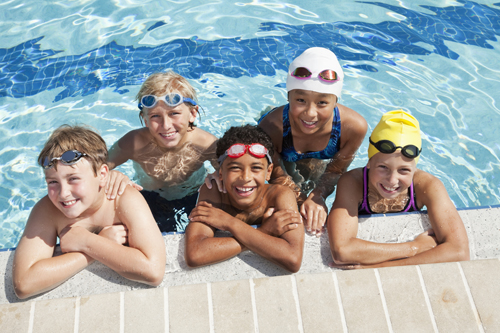
Whether it’s a pool, lake or ocean, summer is the time to make a splash. But before you cannonball into the water, plan ahead and keep in mind important safety tips.
According to the Centers for Disease Control and Prevention (CDC) about 10 people die of accidental drownings a day. It is the second most common cause of death in young children in the U.S. It’s vital that parents take precautions to protect their children, especially when they’re playing in and around the pool and ocean. Keep your child’s swimming adventures safe by following these guidelines.
Keep a Close Eye on the Kids. When you’re swimming with children, it’s all hands on the pool deck. Children must be watched at all times by an adult, no exceptions. Teach your kids how to swim and follow basic safety rules, such as no running around or roughhousing in the water. Children who don’t have strong swimming skills should wear a floatation device such as a life jacket. Parents still need to be vigilant while their children are paddling around. Also, be aware that toddlers can drown in very shallow water, such as a bucket, if not properly supervised.
Be Prepared Before Taking the Plunge. You’ve got your towel, but what about sunscreen? Something to drink (nonalcoholic, of course)? A cell phone in case of emergency? It’s helpful to have all of these on hand. It’s also a good idea to have a flotation device, even if it’s a foam noodle or inflatable raft, which you could toss to a child struggling in the water. Having a first-aid kit nearby also can’t hurt. Make sure you and your child know the depth of the water before diving in. For large bodies of water, have your child stay in designated swimming areas and find out if there are rip currents or tides that can make for unsafe swimming conditions.
Use the Buddy System. Your child should never swim alone. If your child is without a swim partner, make sure there’s a lifeguard watching and that he or she follow the rules of the pool or beach.
Know How to Save a Life. CPR and first-aid courses are easy to find and the time you put into them is paid back in full with the assurance that you know how to handle swimming emergencies with children and adults. Check with your local hospital for a class schedule, or find one online through the American Heart Association’s website. Be aware that not all drowning victims have immediate distress. “Secondary” or “delayed” drowning can take seven hours or longer to develop. Even if a child appears to be OK, he or she should be treated at a hospital if there has been significant choking or aspiration.
Be a Smart Pool Owner. If you have a pool, ensure that you have the proper safety features in place to protect children of all ages.. These can include sturdy pool covers, fences, alarms, rescue equipment and safe drain covers for pools and hot tubs.
Phillip Cecchini, M.D., is a board-certified family medicine physician with Mission Heritage Medical Group, part of the St. Joseph Hoag Health network of care with Mission Hospital.









Leave a Reply